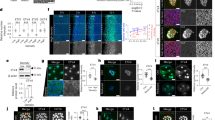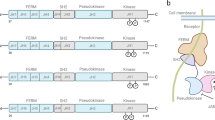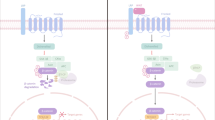Abstract
Clinical studies have revealed that cancer patients whose tumours have increased ErbB2 expression tend to have more aggressive, metastatic disease, which is associated with parameters predicting a poor outcome1,2. The molecular basis underlying ErbB2-dependent cell motility and metastases formation, however, still remains poorly understood. In this study, we show that activation of a set of signalling molecules, including MAPK, phosphatidylinositol-3-OH kinase (PI(3)K) and Src, is required for Neu/ErbB2-dependent lamellipodia formation and for motility of breast carcinoma cells. Stimulation of these molecules, however, failed to induce efficient cell migration in the absence of Neu/ErbB2 phosphorylation at Tyr 1201 or Tyr 1227. We describe a novel molecule, Memo (mediator of ErbB2-driven cell motility), that interacts with a phospho-Tyr 1227-containing peptide, most probably through the Shc adaptor protein. After Neu/ErbB2 activation, Memo-defective cells form actin fibres and grow lamellipodia, but fail to extend microtubules towards the cell cortex. Our data suggest that Memo controls cell migration by relaying extracellular chemotactic signals to the microtubule cytoskeleton.
This is a preview of subscription content, access via your institution
Access options
Subscribe to this journal
Receive 12 print issues and online access
$209.00 per year
only $17.42 per issue
Buy this article
- Purchase on Springer Link
- Instant access to full article PDF
Prices may be subject to local taxes which are calculated during checkout





Similar content being viewed by others
Accession codes
References
Holbro, T. & Hynes, N.E. ErbB Receptors: directing key signaling networks throughout life. Annu. Rev. Pharmacol. Toxicol. 44, 195–217 (2004).
Slamon, D.J. et al. Human breast cancer: correlation of relapse and survival with amplification of the HER-2/neu oncogene. Science 235, 177–182 (1987).
Segatto, O., Lonardo, F., Pierce, J.H., Bottaro, D.P. & Di Fiore, P.P. The role of autophosphorylation in modulation of erbB-2 transforming function. New Biol. 2, 187–195 (1990).
Hazan, R. et al. Identification of autophosphorylation sites of HER2/neu. Cell Growth Differ. 1, 3–7 (1990).
Dankort, D.L., Wang, Z., Blackmore, V., Moran, M.F. & Muller, W.J. Distinct tyrosine autophosphorylation sites negatively and positively modulate neu-mediated transformation. Mol. Cell Biol. 17, 5410–5425 (1997).
Segatto, O. et al. Shc products are substrates of erbB-2 kinase. Oncogene 8, 2105–2112 (1993).
Hellyer, N.J., Kim, M.S. & Koland, J.G. Heregulin-dependent activation of phosphoinositide 3-kinase and Akt via the ErbB2/ErbB3 co-receptor. J. Biol. Chem. 276, 42153–42161 (2001).
Yarden, Y. & Sliwkowski, M.X. Untangling the ErbB signalling network. Nature Rev. Mol. Cell Biol. 2, 127–137 (2001).
Schlessinger, J. Cell signaling by receptor tyrosine kinases. Cell 103, 211–225 (2000).
Klemke, R.L. et al. Regulation of cell motility by mitogen-activated protein kinase. J. Cell Biol. 137, 481–492 (1997).
Zrihan-Licht, S. et al. RAFTK/Pyk2 tyrosine kinase mediates the association of p190 RhoGAP with RasGAP and is involved in breast cancer cell invasion. Oncogene 19, 1318–1328 (2000).
Vadlamudi, R., Adam, L., Talukder, A., Mendelsohn, J. & Kumar, R. Serine phosphorylation of paxillin by heregulin-beta1: role of p38 mitogen activated protein kinase. Oncogene 18, 7253–7264 (1999).
Keely, P.J., Westwick, J.K., Whitehead, I.P., Der, C.J. & Parise, L.V. Cdc42 and Rac1 induce integrin-mediated cell motility and invasiveness through PI(3)K. Nature 390, 632–636 (1997).
Beerli, R.R., Wels, W. & Hynes, N.E. Intracellular expression of single chain antibodies reverts ErbB-2 transformation. J. Biol. Chem. 269, 23931–23936 (1994).
Graus-Porta, D., Beerli, R.R. & Hynes, N.E. Single-chain antibody-mediated intracellular retention of ErbB-2 impairs Neu differentiation factor and epidermal growth factor signaling. Mol. Cell. Biol. 15, 1182–1191 (1995).
Spencer, K.S., Graus-Porta, D., Leng, J., Hynes, N.E. & Klemke, R.L. ErbB2 is necessary for induction of carcinoma cell invasion by ErbB family receptor tyrosine kinases. J. Cell Biol. 148, 385–397 (2000).
Hall, A. Rho GTPases and the actin cytoskeleton. Science 279, 509–514 (1998).
Dankort, D. et al. Grb2 and Shc adapter proteins play distinct roles in Neu (ErbB-2)-induced mammary tumorigenesis: implications for human breast cancer. Mol. Cell. Biol. 21, 1540–1551 (2001).
Lai, C.H., Chou, C.Y., Ch'ang, L.Y., Liu, C.S. & Lin, W. Identification of novel human genes evolutionarily conserved in Caenorhabditis elegans by comparative proteomics. Genome Res. 10, 703–713 (2000).
Traxler, P. et al. Tyrosine kinase inhibitors: from rational design to clinical trials. Med. Res. Rev. 21, 499–512 (2001).
Waterman-Storer, C.M. & Salmon, E. Positive feedback interactions between microtubule and actin dynamics during cell motility. Curr. Opin. Cell Biol. 11, 61–67 (1999).
Enomoto, T. Microtubule disruption induces the formation of actin stress fibers and focal adhesions in cultured cells: possible involvement of the rho signal cascade. Cell Struct. Funct. 21, 317–326 (1996).
Krendel, M., Zenke, F.T. & Bokoch, G.M. Nucleotide exchange factor GEF-H1 mediates cross-talk between microtubules and the actin cytoskeleton. Nature Cell Biol. 4, 294–301 (2002).
Dankort, D., Jeyabalan, N., Jones, N., Dumont, D.J. & Muller, W.J. Multiple ErbB-2/Neu phosphorylation sites mediate transformation through distinct effector proteins. J. Biol. Chem. 276, 38921–38928 (2001).
Ricci, A. et al. Analysis of protein–protein interactions involved in the activation of the Shc/Grb-2 pathway by the ErbB-2 kinase. Oncogene 11, 1519–1529 (1995).
Howard, J. & Hyman, A.A. Dynamics and mechanics of the microtubule plus end. Nature 422, 753–758 (2003).
Sander, E.E. et al. Matrix-dependent Tiam1/Rac signaling in epithelial cells promotes either cell–cell adhesion or cell migration and is regulated by phosphatidylinositol 3-kinase. J. Cell Biol. 143 1385–1398 (1998).
Cho, S.Y. & Klemke, R.L. Extracellular-regulated kinase activation and CAS/Crk coupling regulate cell migration and suppress apoptosis during invasion of the extracellular matrix. J. Cell Biol. 149, 223–236 (2000).
Kisielow, M., Kleiner, S., Nagasawa, M., Faisal, A. & Nagamine, Y. Isoform-specific knockdown and expression of adaptor protein ShcA using small interfering RNA. Biochem. J. 363, 1–5 (2002).
Cappellen, D. et al. Transcriptional program of mouse osteoclast differentiation governed by the macrophage colony-stimulating factor and the ligand for the receptor activator of NFκB. J. Biol. Chem. 277, 21971–21982 (2002).
Acknowledgements
We thank F. Maurer and S. Lienhard for technical assistance, D. Cappellen for help with quantitative PCR and discussions, S. Kleiner for help with siRNA experiments, A. Brahmbhatt and R. Klemke for help with lamellipodia purification, W. Krek, G. Thomas and R. Chiquet for critical reading of the manuscript. This work was supported by the Novartis Research Foundation and grants from the Swiss Cancer League to A.B. and R.M.
Author information
Authors and Affiliations
Corresponding author
Ethics declarations
Competing interests
The authors declare no competing financial interests.
Supplementary information
Supplementary Figures
Fig. S1, Fig. S2, Fig. S3, Fig. S4 (PDF 1900 kb)
Rights and permissions
About this article
Cite this article
Marone, R., Hess, D., Dankort, D. et al. Memo mediates ErbB2-driven cell motility. Nat Cell Biol 6, 515–522 (2004). https://doi.org/10.1038/ncb1134
Received:
Accepted:
Published:
Issue Date:
DOI: https://doi.org/10.1038/ncb1134
This article is cited by
-
Renal FGF23 signaling depends on redox protein Memo1 and promotes orthovanadate-sensitive protein phosphotyrosyl phosphatase activity
Journal of Cell Communication and Signaling (2023)
-
Differential gene expression patterns during gametophyte development provide insights into sex differentiation in the dioicous kelp Saccharina japonica
BMC Plant Biology (2021)
-
SH3BGRL confers innate drug resistance in breast cancer by stabilizing HER2 activation on cell membrane
Journal of Experimental & Clinical Cancer Research (2020)
-
1H, 13C and 15N assignments of the C-terminal intrinsically disordered cytosolic fragment of the receptor tyrosine kinase ErbB2
Biomolecular NMR Assignments (2018)
-
HRG/HER2/HER3 signaling promotes AhR-mediated Memo-1 expression and migration in colorectal cancer
Oncogene (2017)



